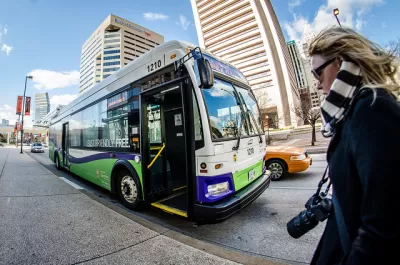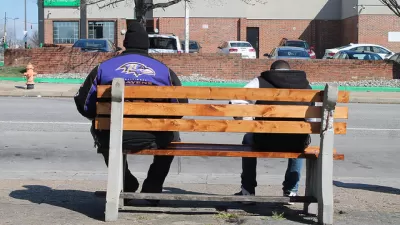A local bus and transit advocate pushes for more improvements to the Maryland Transit Administration's bus system in the city of Baltimore.

Danielle Sweeney checks in with the outcomes of BaltimoreLink, the first substantial redesign of Baltimore's bus system in 50 years, as implemented in June 2017.
According to Sweeney, the redesigned bus system promised "a high-frequency grid, dedicated bus lanes, and transit signal priority corridors that would dramatically improve service." Also, [t]he revamped system was supposed to give more Baltimoreans access to jobs and better connect residents of this high-poverty city to opportunities." Baltimore Mayor Catherine Pugh also "promised that BaltimoreLink would play a key role in the city’s future economic growth."
Initial findings, reported at the end of 2017 and again a year after the system opened, didn't exactly exude positive outcomes. Sweeney's current evaluation continues that theme:
Just before the bus reboot launched in June 2017, I started a Facebook group where riders could document their experiences with the new system. Before I archived it, after 15 months of comments, my group, “Where’s the Bus, Baltimore?” had more than 500 members, including MTA operators, management, and elected officials.
Overall, reviews of the new reboot have been less-than-stellar. Service quality has been all over the road, ridership is flat, and on-time improvements mixed. If you visit Charm City today, you’re likely to experience poorly enforced dedicated bus lanes, buses blamed for the city’s traffic problems, and riders complaining about no-show buses. Many of the dedicated lanes themselves are so faded they are almost invisible, and the MTA and Baltimore’s City’s Department of Transportation have yet to hammer out an agreement for maintaining them. So far, the so-called “transformative” bus system itself has few enthusiasts.
Sweeney provides additional details on the changes made by the BaltimoreLink redesign, a lot more data on whether the program achieved its stated goals, and opinions from local and national transit advocates on the current state of the system and how it could be improved.
FULL STORY: Hard Lessons From Baltimore’s Bus Redesign

Alabama: Trump Terminates Settlements for Black Communities Harmed By Raw Sewage
Trump deemed the landmark civil rights agreement “illegal DEI and environmental justice policy.”

Study: Maui’s Plan to Convert Vacation Rentals to Long-Term Housing Could Cause Nearly $1 Billion Economic Loss
The plan would reduce visitor accommodation by 25% resulting in 1,900 jobs lost.

Why Should We Subsidize Public Transportation?
Many public transit agencies face financial stress due to rising costs, declining fare revenue, and declining subsidies. Transit advocates must provide a strong business case for increasing public transit funding.

Paris Bike Boom Leads to Steep Drop in Air Pollution
The French city’s air quality has improved dramatically in the past 20 years, coinciding with a growth in cycling.

Why Housing Costs More to Build in California Than in Texas
Hard costs like labor and materials combined with ‘soft’ costs such as permitting make building in the San Francisco Bay Area almost three times as costly as in Texas cities.

San Diego County Sees a Rise in Urban Coyotes
San Diego County experiences a rise in urban coyotes, as sightings become prevalent throughout its urban neighbourhoods and surrounding areas.
Urban Design for Planners 1: Software Tools
This six-course series explores essential urban design concepts using open source software and equips planners with the tools they need to participate fully in the urban design process.
Planning for Universal Design
Learn the tools for implementing Universal Design in planning regulations.
Smith Gee Studio
Alamo Area Metropolitan Planning Organization
City of Santa Clarita
Institute for Housing and Urban Development Studies (IHS)
City of Grandview
Harvard GSD Executive Education
Toledo-Lucas County Plan Commissions
Salt Lake City
NYU Wagner Graduate School of Public Service




























